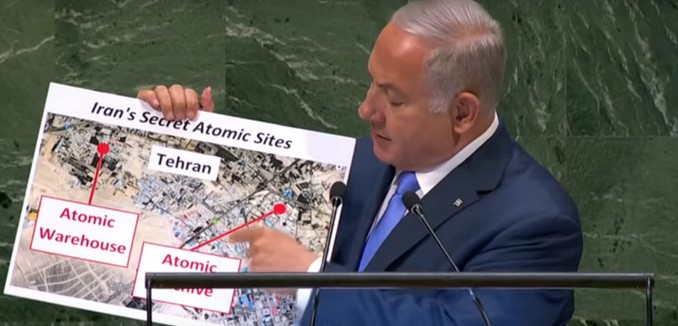Satellite images obtained over the summer confirm charges made by Israeli Prime Minister Benjamin Netanyahu in September that Iran had a secret nuclear warehouse in Tehran, a team of weapons inspectors wrote in a paper published Thursday.
The paper — authored by David Albright, Olli Heinonen, Frank Pabian, and Andrea Stricker — asserted that the satellite pictures show the “steady progression of containers disappearing from the site from July into September,” likely removing “equipment and nuclear material” from the warehouse. Albright is founder and president of the Institute for Science and International Security as well as a former United Nations weapons inspector; Heinonen is a senior advisor to the Foundation for Defense of Democracies and a former Deputy Director General of the International Atomic Energy Agency; Pabian is a former inspector for the IAEA, and Stricker is a senior policy analyst at the Institute.
In his September 27 speech to the United Nations General Assembly, Netanyahu charged that in addition to a nuclear archive — that he had revealed in April — Iran maintained a warehouse of equipment used for its nuclear weapons program.
The paper described images showing some 15 shipping containers by the nuclear warehouse from December 2017 until the middle of this year following the revelation of the nuclear archive.
Despite Iranian denials and claims that the facility identified by Netanyahu was really a carpet cleaner, “photographs and photographic analysis by Israel show that the carpet cleaning site is directly across the street from the actual atomic warehouse,” the paper concluded.
Though Netanyahu had shared the intelligence with the IAEA about the containers leaving the area of the warehouse, the paper noted that “the IAEA did not act on this.” By failing to follow up, “the IAEA may have lost a remarkable opportunity to have asked to go to the site while shipping containers remained there, and irretrievably lost its capability to find the equipment and confirm its true purpose.”
The authors assert that by failing to act, the IAEA lost a chance to ensure implementation of Section T of the nuclear with Iran, which is to ensure that Iran is not pursuing any research that could help it develop nuclear weapons. “The United States has a responsibility,” they wrote, “as a member state of the IAEA, to ensure that such inaction does not continue.”
They also pointed out that the IAEA’s lack of action undermines assurances that “the JCPOA would make it easier to mount inspections when concrete evidence would arise.” Instead, it “validates” concerns of the JCPOA’s critics, who questioned whether it would enhance enforcement of Iran’s obligations.
[Photo: euronews (in English) / YouTube ]




